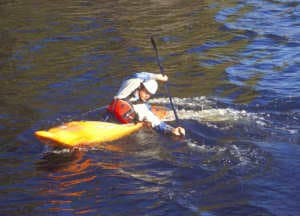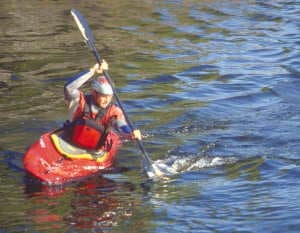Draw Strokes – Bow Draws
As you're discovering, a draw can be placed anywhere along the length of your boat--either statically, by keeping it in one place, or dynamically, by sliding it forward or backward. At each position alongside the boat, the draw stroke will have a different effect. One of the most efficient ways to change the direction of your boat is to move your draw forward where it will act to pull the bow around. Try this in your stationary position first by doing the T-stroke draw with the blade up near your feet, as opposed to beside your hip. You will not have to rotate as far to the side, but your paddle should still be vertical and the blade completely submerged in the water. You should be able to spin the boat in controlled circles in both directions with repeated T-stroke bow draws.
Open-faced Bow Draw
The next step is to get comfortable with the bow draw while your boat is moving forward. Start with a little forward speed in a straight line and then plant the bow draw and cock your wrists slightly outwards to open the face of the paddle. You'll find that the boat turns towards your paddle without your having to pull it in. Because of your forward speed, placing an open-faced bow draw catches "incoming" water and harnesses its power to act on the boat. The forces at play here are very much the same as those you will encounter in moving water. This leads us into taking a closer look at two distinct forms of bow draws that you'll use on the river: the open-faced bow draw and the closed-faced bow draw. It is important to note at this time that bow draws are usually accompanied by a front or back sweep that initiates your spin momentum.

The open-faced bow draw is also commonly referred to as the "Duffek" stroke (named after a Czechoslovakian slalom paddler), and is the most powerful means of turning your kayak when you have forward speed. Since whitewater kayaks are designed to turn very efficiently to begin with, you'll only need to use this stroke in the most aggressive turning situations and when maintaining forward speed is not a real concern, since the stroke acts as a brake. You can plant this bow draw anywhere along the length of your kayak from the very front to directly out to the side of your body. The further out to your side that you plant the stroke, and the more you open the power face, the more powerful your draw will be. By reaching directly out to your side and opening your power face right up, you can catch an incredible amount of water and spin your kayak around very effectively. To harness all this power and keep your shoulders safe at the same time, you'll need to rotate your head and upper body to face your draw. This effectively winds up your body, keeping your hands in front of you in what we call the power position.
Closed-faced Bow Draw
If you don't need to make an ultra-aggressive turn and would like to conserve some of your forward momentum, then the closed-faced bow draw is your best choice. The closed-faced bow draw involves using a draw that doesn't catch water. Instead of being opened to your bow, the power face of your paddle will actually face your body throughout the stroke. Starting with a gliding draw, your paddle will be planted just behind your hip and a foot or two out to the side with the blade parallel to the length of your kayak so that it will slice effortlessly through the water. Your head and upper body should of course be turned to face your paddle, which keeps your shoulders safe. Now slice your draw forward by unwinding your upper body, and begin pulling in on your draw. As you do so, your boat will begin to turn towards your paddle. Make sure that the power face continues to face your body. If it does, then your paddle blade should actually become "closed" to the incoming current as you continue to pull on your draw and slice your paddle forward. This closed-faced draw doesn't act as a brake because it doesn't "catch" incoming water. In fact, it can actually provide your boat with a small amount of added forward momentum.

Ken Whiting was the 1997/98 World Whitewater Freestyle Champion. He has produced an award-winning series of instructional kayaking books and DVDs, and leads kayaking trips to Chile. Look for his new book 'The Ultimate Guide to Whitewater Kayaking', and video 'The Ultimate Guide to Sea Kayaking'. Check out www.helipress.com
Related Articles
Even though they are flipping over, missing their gates and failing their maneuvers, they still look…
In this video, we're going to look at five kayaking tips that will help make you a better paddler, or…
As a member of the US Surf Kayaking Team I had the honor and privilege to compete in the world…
Let's take a look at one of the strokes in the bracing family at the entry level. We have done High…



